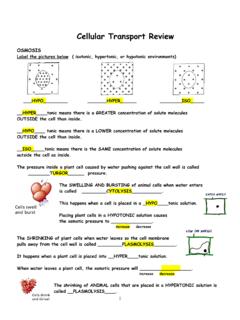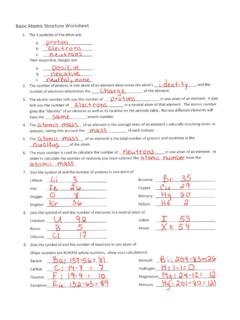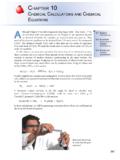Transcription of Chapter 20: Redox Reactions - Neshaminy School District
1 634 Chapter 20 Redox ReactionsCHAPTER20 What You ll LearnYou will examine theprocesses of oxidation andreduction in electron-trans-fer will discover how oxi-dation numbers of elementsin compounds are deter-mined and how they relateto electron will separate redoxreactions into their oxida-tion and u will use two differentmethods to balance oxida-tion reduction It s ImportantOxidation and reduction reac-tions are among the mostprevalent in chemistry . Fromnatural phenomena to com-mercial manufacturing, redoxreactions play a major role inyour daily life. When threatened, the bom-bardier beetle sprays chemicalsfrom its abdomen that, whencombined, undergo an oxida-tion reduction reaction. Theresult is a boiling-hot, foul-smelling "bomb" that allows thebeetle to escape the chemistry Web site find linksabout Redox Oxidation and Reduction635 Objectives Describethe processes ofoxidation and reduction. Identifyoxidizing andreducing agents. Determinethe oxidationnumber of an element in acompound.
2 Interpretredox Reactions interms of change in oxida-tion reductionreactionredox reactionoxidationreductionoxidizing agentreducing and ReductionIn Chapter 10, you learned that a chemical reaction can usually be classified asone of five types synthesis, decomposition, combustion, single-replacement,or double-replacement. In this Chapter , you ll investigate a special characteris-tic of many of these Reactions the ability of elements to gain or lose electronswhen they react with other elements. You experimented with this characteristicwhen you did theDISCOVERY Transfer and Redox ReactionsOne of the defining characteristics of single-replacement and combustionreactions is that they always involve the transfer of electrons from one atomto another. So do many, but not all, synthesis and decomposition example, you studied the synthesis reaction in which sodium and chlo-rine react to form the ionic compound sodium chemical equation: 2Na(s) Cl2(g)02 NaCl(s)Net ionic equation: 2Na(s) Cl2(g)02Na 2Cl (ions in crystal)In this reaction, an electron from each of two sodium atoms is transferred tothe Cl2molecule to form two Cl ions.
3 An example of a combustion reactionis the burning of magnesium in chemical equation: 2Mg(s) O2(g)02 MgO(s)Net ionic equation: 2Mg(s) O2(g)02Mg2 2O2 (ions in crystal)DISCOVERY LABM aterialstest tubeiron nailsteel wool or sandpaper1 Mcopper(II) sulfate (CuSO4)Observing an Oxidation Reduction ReactionRust is the result of a reaction of iron and oxygen. Iron nails canalso react with substances other than oxygen, as you will findout in this PrecautionsAlways wear safety gogglesand an apron in the a piece of steel wool to polish the end of an iron about 3 mL a test tube. Place the polished endof the nail into the CuSO4solution. Let stand and observe forabout 10 minutes. Record your is the substance found clinging to the nail? What happened tothe color of the copper(II) sulfate solution? Write the balancedchemical equation for the reaction you magnesium reacts with oxygen, as illustrated in Figure 20-1, each mag-nesium atom transfers two electrons to each oxygen atom. What is the resultof this electron transfer?
4 The two magnesium atoms become Mg2 ions andthe two oxygen atoms become O2 ions (oxide ions). If you compare this reac-tion with the reaction of sodium and chlorine, you will see that they are alikein that both involve the transfer of electrons between atoms. Areaction in whichelectrons are transferred from one atom to another is called anoxidation reduc-tion reaction. For simplicity, chemists often refer to oxidation reduction reac-tions as Redox consider the single-replacement reaction in which chlorine in anaqueous solution replaces bromine from an aqueous solution of potassium bro-mide, which is shown in Figure chemical equation: 2 KBr(aq) Cl2(aq)02 KCl(aq) Br2(aq)Net ionic equation: 2Br (aq) Cl2(aq)0Br2(aq) 2Cl (aq)Note that chlorine steals electrons from bromide ions to become chlorideions. When the bromide ions lose their extra electrons, the two bromine atomsform a covalent bond with each other to produce Br2molecules. The result ofthis reaction, the characteristic color of elemental bromine in solution, isshown in Figure formation of the covalent bond by sharing of elec-trons also is an oxidation reduction 20 Redox ReactionsFigure 20-1 The reaction of magnesium andoxygen involves a transfer ofelectrons from magnesium tooxygen.
5 Therefore, this reactionis an oxidation reduction reac-tion. Using the classificationsgiven in Chapter 10, this redoxreaction also is classified as acombustion loses2 electronsEach gains2 electrons2 2 2 2 OOOOOOOOOOOOOOOOOOOOOOOOO2 00Br22Br Loses electronEach gains1 electron OOOOOOOOOOOOOO OOOOOXOOOOOOOXOOCl22Cl 00 XXXXXXXXXXXXXX XXXXXXXXL oses electronXXXXXXXXF igure 20-2 Like the reaction shown inFigure 20-1,this reaction ofchlorine and bromine in anaqueous solution is also a redoxreaction. Here, electrons aretransferred from bromide ionsto do oxidation and reduction differ?Originally, the word oxidationreferred only to Reactions in which a substance combined with oxygen, such asthe burning of magnesium in air or the burning of natural gas (methane, CH4)in air. Today, oxidationis defined as the loss of electrons from atoms of a again at the net ionic equation for the reaction of sodium andchlorine. Sodium is oxidized because it loses an electron. To state this reac-tion more clearly,Na0Na e For oxidation to take place, the electrons lost by the substance that is oxi-dized must be accepted by atoms or ions of another substance.
6 In other words,there must be an accompanying process that involves the gain of defined as the gain of electrons by atoms of a our sodium chloride example further, the reduction reaction thataccompanies the oxidation of sodium is the reduction of 2e 02Cl Can oxidation occur without reduction? By our definitions, oxidation andreduction are complementary processes; oxidation cannot occur unless reduc-tion also occurs. It is important to recognize and distinguish between oxidation and reduc-tion. The following memory aid may lion says GERor, for short, LEO GERThis phrase will help you remember that Loss of Electrons is Oxidation, andGain of Electrons is in oxidation numberYou may recall from previous chaptersthat the oxidation numberof an atom in an ionic compound is the numberof electrons lost or gained by the atom when it forms ions. For example, lookat the following equation for the Redox reaction of potassium metal withbromine chemical equation: 2K(s) Br2(g)02 KBr(s)Net ionic equation: 2K(s) Br2(g)02K (s) 2Br (s)Potassium, a group 1A element that tends to lose one electron in reactionsbecause of its low electronegativity, is assigned an oxidation number of the other hand, bromine, a group 7A element that tends to gain one elec-tron in Reactions because of its high electronegativity, is assigned an oxida-tion number of 1.
7 In Redox terms, you would say that potassium atoms areoxidized from 0 to the 1 state because each loses an electron, and bromineatoms are reduced from 0 to the 1 state because each gains an electron. Canyou see why the term reduction is used? When an atom or ion is reduced, thenumerical value of its oxidation number is numbers are tools that scientists use in written chemical equa-tions to help them keep track of the movement of electrons in a Redox reac-tion. Like some of the other tools you have learned about in chemistry ,oxidation numbers have a specific notation. Oxidation numbers are writtenwith the positive or negative sign before the number ( 3, 2), whereas ioniccharge is written with the sign after the number (3 , 2 ).Oxidation number: 3 Ionic charge: 3 Oxidation and Reduction637 BiologyCONNECTIONWhat do the bacteriaXenorhabdus luminescens,fireflies, and many deep-sea fishhave in common? These andother organisms emit is the conversionof potential energy in chemicalbonds into light during a redoxreaction.
8 Bioluminescent light is acold light that gives off littleheat. Depending on the species,bioluminescence is produced bydifferent chemicals and by differ-ent means. In fireflies, for exam-ple, light results from theoxidation of the are still unravelingthe mystery of luminescent organisms emitlight all the time, whereas othersemit light only when they are dis-turbed, such as when churned byocean waves. Deep-sea fish andsome jellyfish appear to be ableto control the light they omit,and one species of mushroom isknown to emit light of two dif-ferent colors. Zoologists have alsodetermined that some light-emit-ting organisms do not producelight themselves, but producelight by harboring appear to use biolu-minescence for different pur-poses. In the ocean depths,bioluminescence probably aidsvision and recognition. Other pur-poses might include mating anddefense against and Reducing AgentsChemists also describe the potassium bromine reaction in another way bysaying that potassium is oxidized by bromine.
9 This description is usefulbecause it clearly identifies both the substance that is oxidized and the sub-stance that does the oxidizing. The substance that oxidizes another substanceby accepting its electrons is called anoxidizing agent. This term is anotherway of saying the substance that is reduced. The substance that reducesanother substance by losing electrons is called areducing agent. A reducingagent supplies electrons to the substance getting reduced (gaining electrons),and is itself oxidized because it loses electrons. By this definition, the reduc-ing agent in the potassium bromine reaction is potassium, the substance thatis application of Redox chemistry is to remove tarnish from metalobjects, such as the silver cups inFigure this tarnish removal technique. Other oxidizing and reducing agentssuch as those shown inFigure 20-4play significant roles in your daily example, when you add chlorine bleach to your laundry to whitenclothes, you are using an aqueous solution of sodium hypochlorite (NaClO),an oxidizing agent.
10 It oxidizes dyes, stains, and other materials that discolorclothes. Hydrogen peroxide (H2O2) can be used as an antiseptic because itoxidizes some of the vital biomolecules of germs, or as an agent to lightenhair because it oxidizes the dark pigment of the (s) Br2(g)02 KBr(s)638 Chapter 20 Redox ReactionsCleaning by RedoxApplying ConceptsThe tarnish on silver is silversulfide, which is formed when the silver reactswith sulfide compounds in the environment. Inthis miniLAB you will use an oxidation reductionreaction to remove the tarnish from silver or a sil-ver-plated foil, steel wool, small tar-nished silver object, 400-mL beaker (or size largeenough to hold the tarnished object), bakingsoda, table salt, hot plate, beaker a piece of aluminum foil lightly with steelwool to remove any oxide the tarnished object in the aluminumfoil, making sure that the tarnished areamakes firm contact with the the wrapped object in the beaker andadd sufficient tap water to about 1 spoonful of baking soda andabout 1 spoonful of table the beaker and contents on a hot plateand heat until the water is nearly the heat approximately 15 min untilthe tarnish the equation for the reaction of silverwith hydrogen sulfide, yielding silver sulfideand the equation for the reaction of the tar-nish (silver sulfide) with the aluminum foil,yielding aluminum sulfide and metal, aluminum or silver, is more reac-tive?



















